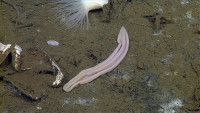
Research Highlight: Deep-Sea Churro Finds its Evolutionary Home
Scripps Institution of Oceanography
Published: 10 February 2016
Scientists discovered four new Xenoturbella worm species, including X. churro, in deep-sea cold seeps and vents. Genetic analysis places them near the base of the animal tree, offering clues to early animal evolution.

Research Highlight: Acoustic Technology Aids Scripps Scientists in Study of Marine Seeps
Scripps Institution of Oceanography
Published: 11 February 2016
Scripps scientists used acoustic monitoring to study methane seeps at a North Sea blowout crater. HARP tech revealed variable emissions, tidal effects, and an eruptive event, offering new ways to track undersea greenhouse gas release.

Around the Pier: El Niño Beach Survey Provides Glimpse of What's to Come for the Coast
Scripps Institution of Oceanography
Published: 11 February 2016
Scripps scientists used airborne lidar and GPS to map Southern California’s beaches and cliffs during the strong 2015–16 El Niño, tracking storm-driven erosion and sea-level rise to improve coastal resilience and future climate adaptation.

